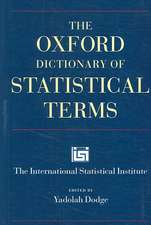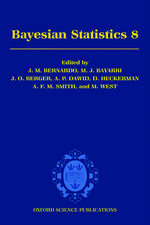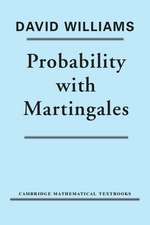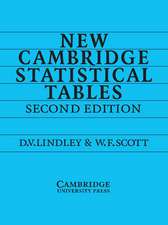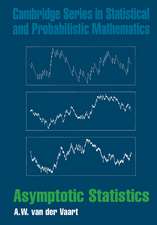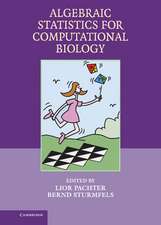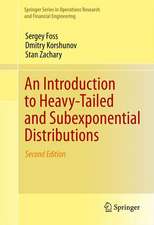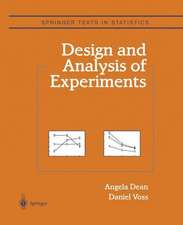Matrix Tricks for Linear Statistical Models: Our Personal Top Twenty
Autor Simo Puntanen, George P. H. Styan, Jarkko Isotaloen Limba Engleză Paperback – oct 2014
In this book we collect together our Top Twenty favourite matrix tricks for linear statistical models.
| Toate formatele și edițiile | Preț | Express |
|---|---|---|
| Paperback (1) | 793.24 lei 43-57 zile | |
| Springer Berlin, Heidelberg – oct 2014 | 793.24 lei 43-57 zile | |
| Hardback (1) | 794.25 lei 43-57 zile | |
| Springer Berlin, Heidelberg – 24 aug 2011 | 794.25 lei 43-57 zile |
Preț: 793.24 lei
Preț vechi: 967.37 lei
-18% Nou
Puncte Express: 1190
Preț estimativ în valută:
151.83€ • 164.98$ • 127.62£
151.83€ • 164.98$ • 127.62£
Carte tipărită la comandă
Livrare economică 21 aprilie-05 mai
Preluare comenzi: 021 569.72.76
Specificații
ISBN-13: 9783642447594
ISBN-10: 3642447597
Pagini: 504
Ilustrații: XVII, 486 p. 70 illus., 35 illus. in color.
Dimensiuni: 155 x 235 x 30 mm
Greutate: 0.77 kg
Ediția:2011
Editura: Springer Berlin, Heidelberg
Colecția Springer
Locul publicării:Berlin, Heidelberg, Germany
ISBN-10: 3642447597
Pagini: 504
Ilustrații: XVII, 486 p. 70 illus., 35 illus. in color.
Dimensiuni: 155 x 235 x 30 mm
Greutate: 0.77 kg
Ediția:2011
Editura: Springer Berlin, Heidelberg
Colecția Springer
Locul publicării:Berlin, Heidelberg, Germany
Public țintă
ResearchCuprins
Introduction.- Easy Column Space Tricks.- Easy Projector Tricks.- Easy Correlation Tricks.- Generalized Inverses in a Nutshell.- Rank of the Partitioned Matrix and the Matrix Product.- Rank Cancellation Rule.- Sum of Orthogonal Projector.- Minimizing cov(y - Fx).- BLUE.- General Solution to AYB = C.- Invariance with Respect to the Choice of Generalized Inverse.- Block-Diagonalization and the Schur Complement.- Nonnegative Definiteness of a Partitioned Matrix.- The Matrix M.- Disjointness of Column Spaces.- Full Rank Decomposition.- Eigenvalue Decomposition.- Singular Value Decomposition.- The Cauchy-Schwarz Inequality.- Notation.- References.- Author Index.- Subject Index.
Recenzii
From the reviews:
“It is for everyone who works on the properties of (multivariate) linear statistical models, especially for graduate students in statistics. Also, the book is … for experts who have had an introduction to multivariate models and have a big preference for matrix results. … book is full of recent results and advances of linear algebra related linear statistical models over the last decades. … book has the potential to become a major reference book for further developments of estimators of linear models in the future.” (Wolfgang Polasek, International Statistical Review, Vol. 81 (1), 2013)
“This new book is closely connected with matrices and linear models … . the authors extract from the matrix algebra and theory of linear models twenty key results or ideas which they call ‘tricks’. … This exceptional book can be recommended to all interested students who wish to improve their skills in linear models and matrix manipulations. It can be recommended also to professors teaching statistics who may utilize this book as a rich source of various exercises, references and interesting historical notes.” (Radosław Kala, IMAGE, Issue 48, Spring, 2012)
“It is for everyone who works on the properties of (multivariate) linear statistical models, especially for graduate students in statistics. Also, the book is … for experts who have had an introduction to multivariate models and have a big preference for matrix results. … book is full of recent results and advances of linear algebra related linear statistical models over the last decades. … book has the potential to become a major reference book for further developments of estimators of linear models in the future.” (Wolfgang Polasek, International Statistical Review, Vol. 81 (1), 2013)
“This new book is closely connected with matrices and linear models … . the authors extract from the matrix algebra and theory of linear models twenty key results or ideas which they call ‘tricks’. … This exceptional book can be recommended to all interested students who wish to improve their skills in linear models and matrix manipulations. It can be recommended also to professors teaching statistics who may utilize this book as a rich source of various exercises, references and interesting historical notes.” (Radosław Kala, IMAGE, Issue 48, Spring, 2012)
Notă biografică
Simo Puntanen earned his PhD in statistics from the University of Tampere (Tampere, Finland) in 1987, where he is now a Docent and Lecturer of Statistics. He has published over 110 research papers in matrix methods for statistics with particular emphasis on linear statistical models. He is currently the book review editor of the International Statistical Review.
George P. H. Styan earned his PhD in mathematical statistics from Columbia University in 1969 and received an Honorary PhD from the University of Tampere in 2000. He is now Professor Emeritus of Mathematics and Statistics at McGill University in Montreal, Canada. He has published over 140 research papers, mostly in matrix methods for statistics, and since 2005, his main interests have focused on magic squares, and mathematical and statistical philately.
Jarkko Isotalo earned his PhD in statistics from the University of Tampere (Tampere, Finland) in 2007, where he is now a Lecturer of Statistics. His main research interests have been linear statistical models, matrix methods for statistics, and computational statistics. He is currently also doing applied research on statistical genetics.
Puntanen, Styan, and Isotalo, knowing just what is expected of authors, would like to agree with P. G. Wodehouse and apologize for childhoods that were as normal as rice-pudding and lives that consisted of little more than sitting in front of the laptop and cursing a bit.
George P. H. Styan earned his PhD in mathematical statistics from Columbia University in 1969 and received an Honorary PhD from the University of Tampere in 2000. He is now Professor Emeritus of Mathematics and Statistics at McGill University in Montreal, Canada. He has published over 140 research papers, mostly in matrix methods for statistics, and since 2005, his main interests have focused on magic squares, and mathematical and statistical philately.
Jarkko Isotalo earned his PhD in statistics from the University of Tampere (Tampere, Finland) in 2007, where he is now a Lecturer of Statistics. His main research interests have been linear statistical models, matrix methods for statistics, and computational statistics. He is currently also doing applied research on statistical genetics.
Puntanen, Styan, and Isotalo, knowing just what is expected of authors, would like to agree with P. G. Wodehouse and apologize for childhoods that were as normal as rice-pudding and lives that consisted of little more than sitting in front of the laptop and cursing a bit.
Textul de pe ultima copertă
In teaching linear statistical models to first-year graduate students or to final-year undergraduate students there is no way to proceed smoothly without matrices and related concepts of linear algebra; their use is really essential. Our experience is that making some particular matrix tricks very familiar to students can substantially increase their insight into linear statistical models (and also multivariate statistical analysis). In matrix algebra, there are handy, sometimes even very simple “tricks” which simplify and clarify the treatment of a problem—both for the student and for the professor. Of course, the concept of a trick is not uniquely defined—by a trick we simply mean here a useful important handy result.
In this book we collect together our Top Twenty favourite matrix tricks for linear statistical models.
In this book we collect together our Top Twenty favourite matrix tricks for linear statistical models.
Caracteristici
A valuable source of information for graduate studies whenever the matrix analysis and/or linear statistics is involved Useful to the researchers utilizing matrices to deal with problems originating in various sciences, not only statistics Collected 'Top Twenty' favorite matrix tricks for linear statistical models


